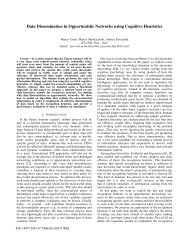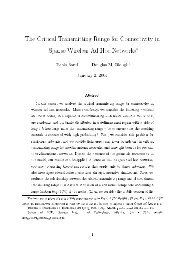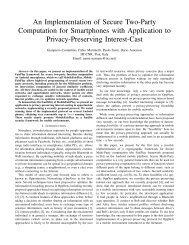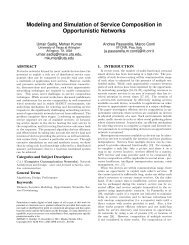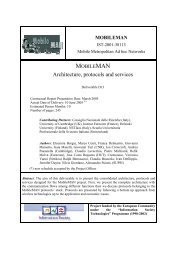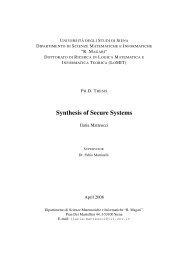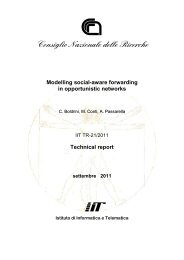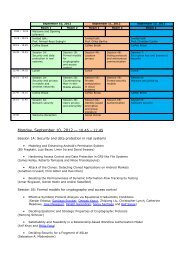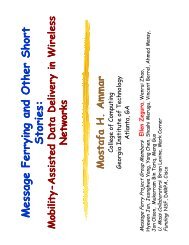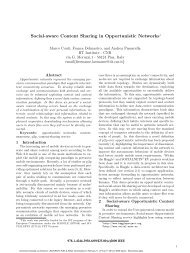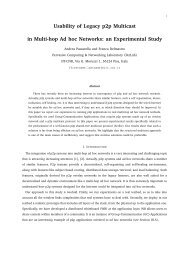Download - Istituto di Informatica e Telematica - Cnr
Download - Istituto di Informatica e Telematica - Cnr
Download - Istituto di Informatica e Telematica - Cnr
- No tags were found...
Create successful ePaper yourself
Turn your PDF publications into a flip-book with our unique Google optimized e-Paper software.
Prefixing: a a.x −→ x Choice: x −→ a x ′ y −→ a y ′x + y −→ a x ′ x + y −→ a y ′Parallel: x −→ a x ′ y −→ a y ′ x −→ l x ′ ¯ly −→ y ′x‖y −→ a x ′ ‖y x‖y −→ a x‖y ′ x‖y −→ τ x ′ ‖y ′Restriction: x −→ a x ′x\L −→ a x ′ \L Relabeling: x −→ a x ′x[f] −→ f(a)x ′ [f]Table 1GSOS system for CCS.exists a unique transition relation induced by a GSOS system (see [4]) and this transitionrelation is finitely branching.2.1.2 An example: CCS process algebraCCS of Milner (see [13]) is a language for describing concurrent systems. Here, wepresent a formulation of Milner’s CCS in the GSOS format.The main operator is the parallel composition between processes, namely E‖F because,as we explain better later, it permits to model the parallel composition of processes.The notion of communication considered is a synchronous one, i.e. both processes mustagree on performing the communication at the same time. It is modeled by a simultaneousperforming of complementary actions that is represented by a synchronization action (orinternal action) τ.Let L be a finite set of actions, ¯L = {ā | a ∈ L} be the set of complementary actionswhere¯is a bijection with ā = a, Act be L∪ ¯L∪{τ}, where τ is a special action that denotesan internal computation step (or communication) and Π be a set of constant symbols thatcan be used to define processes with recursion. To give a formulation of CCS dealing withGSOS, we define the signature Σ CCS = (F CCS , ar) as follows.F CCS = {0, +, ‖} ∪ {a.|a ∈ Act} ∪ {\L|L ⊆ L ∪ ¯L} ∪ {[f]|f : Act ↦→ Act} ∪ Π.The function ar is defined as follows: ar(0) = 0 and for every π ∈ Π we have ar(π) = 0,‖ and + are binary operators and the other ones are unary operators.The operational semantics of CCS closed terms is given by means of the GSOS systemin table 1 and it is described by an LT S. We denote by Der(E) the set of derivativesof a (closed) term E, i.e. the set of process that can be reached through the transitionrelation. Informally, a (closed) term a.E represents a process that performs an action aand then behaves as E. The term E + F represents the non-deterministic choice betweenthe processes E and F . Choosing the action of one of the two components, the other isdropped. The term E‖F represents the parallel composition of the two processes E andF . It can perform an action if one of the two processes can perform an action, and thisdoes not prevent the capabilities of the other process. The third rule of parallel compositionis characteristic of this calculus, it expresses that the communication between processeshappens whenever both can perform complementary actions. The resulting process is givenby the parallel composition of the successors of each component, respectively. The processE\L behaves like E but the actions in L ∪ ¯L are forbidden. To force a synchronizationon an action between parallel processes, we have to set restriction operator in conjunctionwith parallel one. The process E[f] behaves like the E but the actions are renamed viaf.4
2.1.3 Behavioral relation: SimulationIt is often necessary to compare processes that are expressed using <strong>di</strong>fferent terms in orderto understand if there exists some behavioral relation between two processes and which one(see [13]).We present the notion of observational relation as follows.E ⇒ τ E ′ (or E ⇒ E ′ ) if E → τ ∗ E ′ (where → τ ∗ is the reflexive and transitive closure of theτ→ relation); E ⇒ a E ′ if E ⇒ τ → a ⇒ τ E ′ . 4Now we are able to give the following definition.Definition 2.1 Let (E, T ) be an LTS of concurrent processes, and let R be a binary relationover a set of process E. Then R is said to be a simulation (denoted by ≼) if, whenever(E, F ) ∈ R, if E a → E ′ then ∃F ′ ∈ E s.t. F a ⇒ F ′ and (E ′ , F ′ ) ∈ R.2.2 Equational µ-calculus and partial model checkingEquational µ-calculus is a process logic well suited for specification and verification ofsystems whose behavior is naturally described using state changes by means of actions. Itpermits to express a lot of interesting properties like safety and liveness properties, as wellas allowing to express equivalence con<strong>di</strong>tions over LTS. In order to define recursively theproperties of a given system, this calculus uses fixpoint equations. Let a be in Act and Xbe a variable ranging over a finite set of variables V . As we have already said, equationalµ-calculus is based on fixpoint equations that substitute recursion operators. X = µ A is aminimal fixpoint equation, where A is an assertion (i.e. a simple modal formula withoutrecursion operator), and X = ν A is a maximal fixpoint equation. The syntax of the assertions(A) and of the lists of equations (D) is given by the following grammar:A ::= X | T | F | A 1 ∧ A 2 | A 1 ∨ A 2 | 〈a〉A | [a]AD ::= X = ν AD | X = µ AD | ɛwhere the symbol T means true and F means false; ∧ is the symbol of the standard conjunctionof formulae, i.e. A 1 ∧ A 2 holds iff both of the formulae A 1 and A 2 hold, and ∨is the <strong>di</strong>sjunction of formulae, so A 1 ∨ A 2 holds when at least one of A 1 and A 2 holds.Moreover 〈a〉A is the (possibility operator). It means that “exists a transition labeled by aafter that A holds”. On the other hand, [a]A is the (necessity operator) and means “for alltransitions labeled by a, A holds”. Roughly, the semantics D of the list of equations Dis the solution of the system of equations correspon<strong>di</strong>ng to D . Accor<strong>di</strong>ng to this notation,D(X) is the set of values of the variable X, and E |= D ↓ X can be used as a shortnotation for E ∈ D(X). The formal semantics is in Table 2. The following standardresult of µ-calculus will be useful in the reminder of the paper.Theorem 2.2 ([18]) Given a formula φ it is possible to decide in exponential time in thelength of φ if there exists a model of φ and it is also possible to give an example of suchmodel.Partial model checking (pmc) is a technique that was originally developed for compositionalanalysis of concurrent systems (processes) (see [1]). In order to explain how partialmodel checking works, we give the intuitive idea underlying it describing pmc w.r.t. theparallel operator as follows: proving that E‖F satisfies a formula φ (E‖F |= φ) is equivalentto proving that F satisfies a mo<strong>di</strong>fied specification φ //E (F |= φ //E ), where // E is4 Note that it is a short notation for E ⇒ τ aE τ → E ′ ττ ⇒ E ′ where E τ and E τ ′ denote interme<strong>di</strong>ate states (not relevant inour framework).5
of only one action, i.e., using the function γ, it controls if a wrong action is performed.If it holds, the automaton inserts a finite sequence of actions, hence a finite number ofinterme<strong>di</strong>ate states. Without loss of generality, we consider that it performs only oneaction. In this way we openly consider all interme<strong>di</strong>ate states. Note that the domain of γis <strong>di</strong>sjoint from the domain of δ in order to have a deterministic automata.if σ = a; σ ′ and δ(a, q) = q ′ (σ, q)if σ = a; σ ′ and γ(a, q) = (b, q ′ )(σ, q)a−→ I (σ ′ , q ′ )b−→ I (σ, q ′ )(I-Step)(I-Ins)otherwise(σ, q)τ−→ I (·, q)(I-Stop)E<strong>di</strong>t automaton. It is defined as (Q, q 0 , δ, γ, ω) where γ : Act × Q → Act × Q thatspecifies the insertion of a finite sequence of actions into the program’s actions sequenceand ω : Act × Q → {−, +} in<strong>di</strong>cates whether or not the action in question should besuppressed (-) or emitted (+). Also here ω and δ have the same domain while the domainof γ is <strong>di</strong>sjoint from the domain of δ in order to have a deterministic automata.if σ = a; σ ′ and δ(a, q) = q ′ and ω(a, q) = +(σ, q)a−→ E (σ ′ , q ′ )(E-StepA)if σ = a; σ ′ and δ(a, q) = q ′ and ω(a, q) = −(σ, q)τ−→ E (σ ′ , q ′ )(E-StepS)if σ = a; σ ′ and γ(a, q) = (b, q ′ )otherwise(σ, q)(σ, q)b−→ E (σ, q ′ )τ−→ E (·, q)(E-Ins)(E-Stop)3 Modeling security automata with process algebraIn this section we give the semantics of some process algebra operators, denoted by Y ⊲ KX where K ∈ {T, S, I, E} 7 , that act as controller operators. These permit to controlthe behavior of the (possibly untrusted) component X, given the behavior of the controlprogram Y .3.1 Our controller operators in process algebraHere we define our controller operators by showing their behavior trought semantics rules.We denote with E the program controller and with F the target. We work, without loss ofgenerality, under the ad<strong>di</strong>tional assumption that E and F never perform the internal actionτ.7 We choose these symbols to denote four operators that have the same behavior of truncation, suppression, insertion ande<strong>di</strong>t automata, respectively.8
3.1.1 Truncation automata: ⊲ TE a → E ′ F a → F ′E ⊲ T F → a E ′ ⊲ T F ′This operator models the truncation automaton that is similar to Schneider’s automaton(when considering only deterministic automata, e.g., see [3,6]). Its semantics rule statesthat if F performs the action a and the same action is performed by E (so it is allowed inthe current state of the automaton), then E ⊲ T F performs the action a, otherwise it halts.⎧Proposition 3.1 Let E q = ∑ ⎨ a.E q′ iff δ(a, q) = q ′a∈Act\{τ}⎩ 0 othwbe the control process and let F be the target. Each sequence of actions that is an outputof a truncation automaton (Q, q 0 , δ) is also derivable from E q ⊲ T F and vice-versa.3.1.2 Suppression automata: ⊲ SE a → E ′ F a → F ′E −a −→ E ′ F a → F ′E ⊲ S F → a E ′ ⊲ S F ′ E ⊲ S F → τ E ′ ⊲ S F ′where −a is a control action not in Act (so it does not admit a complementary action). Asfor the truncation automaton, if F performs the same action performed by E also E ⊲ S Fperforms it. On the contrary, if F performs an action a that E does not perform and E canperform the control action −a then E ⊲ S F performs the action τ that suppresses the actiona, i.e., a becomes not visible from external observation. Otherwise, E ⊲ S F halts.⎧Proposition 3.2 LetE q,ω = ∑ a.E ⎪⎨q′ ,ω iff ω(a, q) = + and δ(a, q) = q ′a∈Act\{τ} −a.E q′ ,ω iff ω(a, q) = − and δ(a, q) = q ′⎪⎩ 0 othwbe the control process and let F be the target. Each sequence of actions that is an outputof a suppression automaton (Q, q 0 , δ, ω) is also derivable from E q,ω ⊲ S F and vice-versa.3.1.3 Insertion automata: ⊲ IE a → E ′ F a → F ′aE ̸→ E ′E +a.b −→ E ′ F a → F ′E ⊲ I F → a E ′ ⊲ I F ′ E ⊲ I F → b E ′ ⊲ I Fwhere +a is an action not in Act. If F performs an action a that also E can perform, thewhole system makes this action. If F performs an action a that E does not perform and Edetects it by performing a control action +a followed by an actio b, then the whole systemperform b. It is possible to note that in the description of insertion automata in [3] thedomains of γ and δ are <strong>di</strong>sjoint. In our case, this is guarantee by the premise of the secondarule in which we have that E ̸−→ E ′ , E −→ +a.b E ′ . In fact for the insertion automata, if apair (a, q) is not in the domain of δ and it is in the domain of γ it means that the actiona and the state q are not compatible so in order to change state an action <strong>di</strong>fferent from amust be performed. It is important to note that it is able to insert new actions but it is notable to suppress any action performed by F .8 This means E −→ +a bE a −→ E ′ . However we consider +a.b as a single action, i.e. the state E a is hide and we do notconsider it in Der(E).98
⎧Proposition 3.3 Let E q,γ = ∑ a.E ⎪⎨q′ ,γ iff δ(a, q)a∈Act\{τ} +a.b.E q′ ,γ iff γ(a, q) = (b, q ′ )⎪⎩ 0 othwbe the control process and let F be the target. Each sequence of actions that is an outputof an insertion automaton (Q, q 0 , δ, γ) is also derivable from E q,γ ⊲ I F and vice-versa.3.1.4 E<strong>di</strong>t automata: ⊲ EIn order to do insertion and suppression together we define the following controller operator.Its rules are the union of the rules of the ⊲ S and ⊲ I .E a → E ′ F a → F ′E ⊲ E F a → E ′ ⊲ E F ′E −a −→ E ′ F a → F ′E ⊲ E F τ → E ′ ⊲ E F ′aE ̸→ E ′E ⊲ E FE +a.b → E ′ F a → F ′b → E ′ ⊲ E FThis operator combines the power of the previous two ones.⎧a.E q′ ,γ,ω iff δ(a, q) = q ′ and ω(a, q) = +Proposition 3.4 Let E q,γ,ω = ∑ ⎪⎨ −a.E q′ ,γ,ω iff δ(a, q) = q ′ and ω(a, q) = −a∈Act\{τ}+a.b.E q′ ,γ,ω iff γ(a, q) = (b, q ′ )⎪⎩ 0 othwbe the control process and let F be the target. Each sequence of actions that is an outputof an e<strong>di</strong>t automaton (Q, q 0 , δ, γ, ω) is also derivable from E q,γ,ω ⊲ E F and vice-versa.It is important to note that we introduced the control action −a in the semantics of ⊲ Sand +a in the semantics of ⊲ I in order to find operators that were as similar as possibleto suppression and insertion automata, respectively. Other definitions could be possible,although some attempts we made failed on defining a tractable semantics.4 Synthesis of controller programsExploiting our framework we can build a program controller Y which allows to enforce adesired security property for any target system X. We present an extension of [10]. Herewe have four <strong>di</strong>fferent operators and in particular we have to deal with control actions.Let S be a system, and let X be one component that may be dynamically changed (e.g.,a downloaded mobile agent) that we consider a possibly untrusted one. We would like thatfor any actual behavior of X, the system S‖X enjoys a security property expressed by alogical formula φ, i.e., ∀X (S‖X) |= φ.In order to protect the system we might simply check the correctness of each process Xbefore it is executed or, if this is not possible (or not desirable), we may define a controllerthat, in any case, forces each process to behave correctly. Here, we study here how to builda program controller in order to force the unknown component to behave correctly. Thus,we want to find a control program Y such that:∀X (S‖Y ⊲ K X) |= φ (2)By using the partial model checking approach proposed in [9], we can focus on theproperties of Y ⊲ K X, i.e.:∃Y ∀X (Y ⊲ K X) |= φ ′ (3)10
where φ ′ = φ //S .In order to manage the universal quantification in (3), we prove the following proposition.Proposition 4.1 For every K ∈ {T, S, I, E} Y ⊲ K X ≼ Y [f K ] holds, where f K is arelabeling function depen<strong>di</strong>ng on K. In particular, f T is the identity function on Act 9 and⎧⎧⎧⎨ τ if a = −a⎨ τ if a = +a⎨ τ if a ∈ {+a, −a}f S (a) =f⎩I (a) =fa othw⎩E (a) =a othw⎩ a othwNow we restrict ourselves to a subclass of equational µ-calculus formulae that is denotedby F r µ . This class consists of equational µ-calculus formulae without 〈 〉. It is easyto prove that this set of formulae is closed under the partial model checking function andthe following result holds.Proposition 4.2 Let E and F be two finite state processes and φ ∈ F r µ . If F ≼ E thenE |= φ ⇒ F |= φ.At this point in order to satisfy the formula (3) it is sufficient to have:∃Y Y [f K ] |= φ ′To further reduce the previous formula, we can use the partial model checking function forrelabeling operator. Hence, for every K ∈ {T, S, I, E} we calculate φ ′′ K = φ′ // [fK ] . Thuswe obtain:∃Y Y |= φ ′′ K 10 (4)In this way, we obtain a satisfiability problem in µ-calculus that can be solved by Theorem2.2.5 Synthesis of Maximal ModelIn the previous section we have shown a method to synthesize a program controller for eachof controller operators defined in section 3.1. As matter of fact, we find a deterministicprocess that does not perform τ actions and that is a model for a given µ-calculus formula.In this section we define the notion of maximal model w.r.t. the simulation relationand show how it is possible to synthesize a maximal program controller Y for the operatorY ⊲ T X.We define the notion of maximal model w.r.t. the relation of simulation as follows.A process E is a maximal model for a given formula φ iff E |= φ and ∀E ′ s.t. E ′ |=φ, E ′ ≼ E (see [15,16]). Informally, the maximal program controller Y is the process thatrestricts as little as possible the activity of the target X.In order to find the maximal model we exploit the theory developed by Walukiewicz in[19].Usually the <strong>di</strong>scovered model is a non-deterministic process. In order to find a deterministicmodel we consider a subset of formulae of F r µ without ∨. This set of formulae is9 Here the set Act must be consider enriched by control actions.10 Even if the process Y performs some actions τ it is possible to obtain from Y another process Y ′ with only visible actionsthat is a deterministic model of φ.11
called the universal conjunctive µ-calculus formulae, ∀ ∧ µC. It is easy to prove that ∀ ∧ µCis closed under the partial model checking function (see [5]).Proposition 5.1 Given a formula φ ∈ ∀ ∧ µC, a maximal deterministic model E of thisformula exists.In order to generate the maximal model E, we find a model for φ ∧ ψ where ψ = X,X = ν∧α∈Act\{τ}([α]F ∨ (〈α〉X ∧ [α]X)). The formula ψ permits us to check all theactions in Act. Exploiting the theory of Walukievicz, we find a deterministic model E forφ ∧ ψ that does not perform τ actions. It is obviously a model of φ. The following lemmaholds.Lemma 5.2 Let E ′ |= φ with φ ∈ ∀ ∧ µC. Then the model of φ ∧ ψ E, is such that E ′ ≼ E.Hence E is the maximal model for φ.6 A simple exampleConsider the process S = a.b.0 and consider the following equational definition φ = Zwhere Z = ν [τ]Z ∧ [a]W and W = ν [τ]W ∧ [c]F. It asserts that after every action a, anaction c cannot be performed. Let Act = {a, b, c, τ, ā, ¯b, ¯c} be the set of actions. Applyingthe partial evaluation for the parallel operator we obtain, after some simplifications, thefollowing system of equation, that we denoted with D.Z //S = ν [τ]Z //S ∧ [ā]Z //S ′ ∧ [a]W // S∧ W //S ′Z //0 = TW //S ′= ν [τ]W //S ′ ∧ [¯b]W //0 ∧ [c]F W //0 = TZ //S ′= ν [τ]Z //S ′ ∧ [¯b]Z //0 ∧ [a]W //S ′W //S = ν [τ]W //S ∧ [ā]W ∧ [c]F//S ′where S −→ a S ′ so S ′ is b.0.The information obtained through partial model checking can be used to enforce asecurity policy. In particular, choosing one of the four operators and using its definition wesimply need to find a process Y [f K ], where K depend on the chosen controller, that is amodel for the previous formula.In this simple example we choose the controller operator ⊲ S . Hence we apply the partialmodel checking for relabeling function f S to the previous formula, that we have simplifiedreplacing W //0 and Z //0 by T (and assumed that Y can only suppress c actions). Weobtain D //fS as follows.Z //S,fSW //S ′ ,fS= ν [τ]Z //S,fS ∧ [−c]Z //S,fS ∧ [ā]Z //S ′ ,fS∧ [a]W //S,fS ∧ W //S ′ ,fS= ν [τ]W //S ′ ,fS∧ [−c]W //S ′ ,fS∧ [¯b]T ∧ [c]FZ //S ′ ,fS= ν [τ]Z //S ′ ,fS∧ [−c]Z //S ′ ,fS∧ [¯b]T ∧ [a]W //S ′ ,fSW //S,fS = ν [τ]W //S,fS ∧ [−c]W //S,fS ∧ [ā]W //S ′ ,fS∧ [c]FWe can note the process Y = a. − c.0 is a model of D //fS . Then, for any component X,we have S‖(Y ⊲ S X) satisfies φ. For instance, consider X = a.c.0. Looking at the firstrule of ⊲ S , we have:a(S‖(Y ⊲ S X)) = (a.b.0‖(a. − c.0 ⊲ S a.c.0)) −→ (a.b.0‖(−c.0 ⊲ S c.0))Using the second rule we eventually get:τ(a.b.0‖(−c.0 ⊲ S c.0)) −→ (a.b.0‖0 ⊲ S 0)12
and so the system still preserves its security since the actions performed by the componentX have been prevented from being visible outside.7 Conclusion and Future workWe illustrated some results towards a uniform theory for enforcing security properties.With this work, we extended a framework based on process calculi and logical techniques,that have been shown to be very suitable to model and verify several security properties, totackle also synthesis problems of secure systems.As future work we plan to implement the theory here showed in order to generate theprogram controllers and to extend it in other application scenarios as the time-based ones.Acknowledgement We thank the anonymous referees of STM06 for valuable commentsthat helped us to improve this paper.References[1] Andersen, H. R., Partial model checking, in: LICS ’95: Procee<strong>di</strong>ngs of the 10th Annual IEEE Symposium on Logic inComputer Science (1995), p. 398.[2] Bartoletti, M., P. Degano and G. Ferrari, Policy framings for access control, in: Procee<strong>di</strong>ngs of the 2005 workshop onIssues in the theory of security, Long Beach, California, 2005, pp. 5 – 11.[3] Bauer, L., J. Ligatti and D. Walker, More enforceable security policies, in: I. Cervesato, e<strong>di</strong>tor, Foundations of ComputerSecurity: procee<strong>di</strong>ngs of the FLoC’02 workshop on Foundations of Computer Security (2002), pp. 95–104.[4] Bloom, B., S. Istrail and A. R. Meyer, Bisimulation can’t be traced, J.ACM 42 (1995).[5] Gnesi, S., G. Lenzini and F. Martinelli, Logical specification and analysis of fault tolerant systems through partialmodel checking, International Workshop on Software Verification and Validation (SVV), ENTCS. (2004).[6] Ligatti, J., L. Bauer and D. Walker, E<strong>di</strong>t automata: Enforcement mechanisms for run-time security policies, InternationalJournal of Information Security 4 (2005).[7] Ligatti, J., L. Bauer and D. Walker, Enforcing non-safety security policies with program monitors, in: 10th EuropeanSymposium on Research in Computer Security (ESORICS), 2005.[8] Martinelli, F., “Formal Methods for the Analysis of Open Systems with Applications to Security Properties,” Ph.D.thesis, University of Siena (1998).[9] Martinelli, F., Partial model checking and theorem proving for ensuring security properties, in: CSFW ’98: Procee<strong>di</strong>ngsof the 11th IEEE Computer Security Foundations Workshop (1998).[10] Martinelli, F. and I. Matteucci, Partial model checking, process algebra operators and satisfiability procedures for(automatically) enforcing security properties, Presented at the International Workshop on Foundations of ComputerSecurity (FCS05) (2005).[11] Martinelli, F. and I. Matteucci, Modeling security automata with process algebras and related results (2006), presentedat the 6th International Workshop on Issues in the Theory of Security (WITS ’06) - Informal procee<strong>di</strong>ngs.[12] Milner, R., Synthesis of communicating behaviour, in: Procee<strong>di</strong>ngs of 7th MFCS, Poland, 1978.[13] Milner, R., “Communicating and mobile systems: the π-calculus,” Cambridge University Press, 1999.[14] Müller-Olm, M., Derivation of characteristic formulae, in: MFCS’98 Workshop on Concurrency, Electronic Notes inTheoretical Computer Science (ENTCS) 18 (1998).[15] Riedweg, S. and S. Pinchinat, Maximally permissive controllers in all contexts, in: Workshop on Discrete Event Systems,Reims, France, 2004.[16] Riedweg, S. and S. Pinchinat, You can always compute maximally permissive controllers under partial observationwhen they exist., in: Proc. 2005 American Control Conference., Portland, Oregon, 2005.[17] Schneider, F. B., Enforceable security policies, ACM Transactions on Information and System Security 3 (2000),pp. 30–50.[18] Street, R. S. and E. A. Emerson, An automata theoretic procedure for the propositional µ-calculus, Information andComputation 81 (1989), pp. 249–264.[19] Walukiewicz, I., “A Complete Deductive System for the µ-Calculus,” Ph.D. thesis, Institute of Informatics, WarsawUniversity (1993).13



